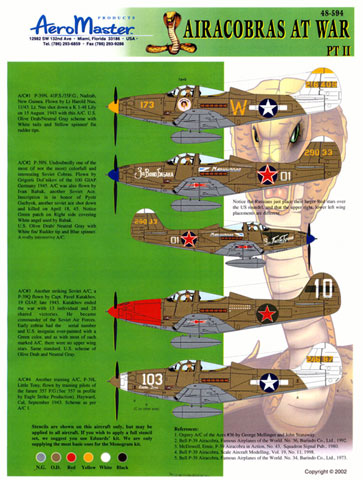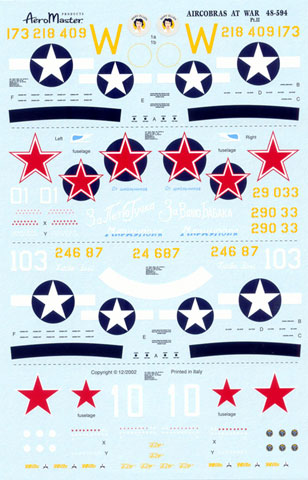|
 Airacobras Airacobras
At War
Part Two
Aeromaster
Decals
|
S u m m a r y
|
|
Catalogue Number: |
AMD 48-594 - AIRACOBRAS
AT WAR PART II |
|
Scale: |
1/48 |
|
Contents and Media: |
Waterslide
decals - Decal sheets plus instructions and notes |
| Price: |
USD$7.97 from Squadron.com |
| Review
Type: |
FirstLook |
|
Advantages: |
Perfect
register; thin; minimal carrier film; comprehensive
stencil data; bonus decals supplied; good
instructions and background |
|
Disadvantages: |
|
|
Recommendation: |
Recommended
|
Reviewed
by Rodger Kelly

HyperScale is proudly
supported by Squadron.com
|
AeroMaster Products 48-594 is the second sheet in its P-39
Airacobra trilogy. As with the other two sheets, this one
carries markings for four P-39s,
two -Ns, an -L and a –Q.
 First
up is MARY ELLEN, 42-18409, a P-39N, of the 41st
Fighter Squadron 35th Fighter Group. MARY
ELLEN was flown by a LT Harold Nus out of Nadzab, New
Guinea in November 1943. Finish is olive drab over neutral
grey with white tail theatre markings. MARY ELLEN
also bears the 41st Fighter Squadron’s markings of yellow
spinner and tail tip. Supplied markings consist of: First
up is MARY ELLEN, 42-18409, a P-39N, of the 41st
Fighter Squadron 35th Fighter Group. MARY
ELLEN was flown by a LT Harold Nus out of Nadzab, New
Guinea in November 1943. Finish is olive drab over neutral
grey with white tail theatre markings. MARY ELLEN
also bears the 41st Fighter Squadron’s markings of yellow
spinner and tail tip. Supplied markings consist of:
·
Early USAAF national insignia of a white star on a blue
circle background with field applied white bars in four
places.
·
Yellow 173 “plane in squadron” number for the nose.
·
Yellow W “Flight letter” for the fuselage.
·
Yellow aircraft serial number for the tail. The serial is
applied on an olive drab background, which was no doubt
masked off when the white theatre markings were applied to
the 1 to 1 scale machine. The easiest way to replicate this
marking and save yourself the hassle of trying to spray
white over olive drab is to spray some clear decal film with
the same olive drab paint that you applied to the rest of
the airframe. Once dry, trim an olive drab rectangle from
the sheet and then apply it over the top of the white tail.
Wait for the olive drab decal to dry then apply the yellow
serial on to it and voila!
·
“Door art” consisting of a head and shoulders portrait of a
woman on a light tan and yellow circle background with the
words
MARY
ELLEN.
·
The
remainder of the markings are in black and include the
walkways for either wing as well as the serial data block
and a selection of stencil data.
The next option
is 42-9033, a P-39N of the VVS (Russian Army Air Force).
This is an interesting aircraft. Apart from its colourful
markings it was also flown by two Russian Aces (albeit with
different markings). The markings chosen for this sheet
however are those of Grigorii Dol’nikov of the 100 GIAP and
flown in German skies during 1945. Finish is olive drab
over neutral grey with a blue spinner and a white fin tip.
Supplied markings consist of:
·
Russian national insignia in six positions. Four of these
insignia are supplied with blue circle backgrounds. This is
because the Russians simply applied their red star markings
over the top of existing U.S. national insignia when they
were delivered rather than painting them out.
·
White 01 “Bort” numbers.
·
Blue and white Cyrillic scripts which translated mean “From
the schoolchildren of Mariupol”.
·
Further white Cyrillic scripts for either sides of the
nose. The left hand side one translating to “For Vanya
Babak” and the right hand side one to “For Petya Guchyok”
both of whom were fallen members of the VVS.
·
A
scoreboard of 15 red and white Russian stars for the right
side of the nose. Two different sets of these markings are
supplied. One set is simply white stars that you apply
smaller red stars over the top of. I guess that they have
gone this way to avoid any register problems not there are
any on my sample. Curiously though there are two complete
sets were only one is required.
·
Yellow aircraft serial numbers for either side of the fin
and rudder. AeroMaster give you the option here of two
different decals for the left hand side as they are unsure
of how the serial number was split between the fin and
rudder.
·
A
black stencil data block.
The third option
is another VVS machine, a P-39Q, (unknown serial number)
flown by CAPT Pavel Kutakhov of the 19th GIAP in
late 1943. The aircraft is finished in olive drab over
neutral grey with its entire nose and spinner in red.
Markings consist of:
·
National insignia in four places (either side of the
fuselage and on the lower surfaces of both wings). Unlike
the previous machine, this one had the blue and white U.S.
national insignia over painted with fresh “green” paint on
delivery. No green background is supplied so you will have
to either paint them on yourself or cut some from a solid
“green” decal sheet for the fuselage and upper left wing. A
similar approach will also be required for the underside of
the right wing in a suitable “grey” to cover the U.S.
Marking that would have been painted there.
·
White 10 Bort number for the tail. The serial number has
also been painted out and again, no “green” decal is
provided so you will have to do this yourself too.
·
A
scoreboard consisting of eight red and white stars and
thirteen white stars. As with the previous machine, this
marking is provided as either a two-part decal or a single
all-inclusive one. Again, two complete sets are supplied
where only one is required.
·
A
black stencil data block.
The final option
is another USAAF aircraft. P-39L 42-4687, “Little Toni”.
The placement sheet advises that the aircraft was “flown by
training pilots of the future 357th Fighter
Group” out of Hayward, California in September of 1943.
Finish is again, olive drab over neutral grey and, although
based in the continental U.S. it bears the Pacific Theatre
markings of a white empanage. The use of white paint is
further extended to a broad ring around the nose. Supplied
markings consist of:
·
Early USAAF national insignia of a white star on a blue
circle background with field applied white bars in four
places.
·
White 103 “plane in squadron number” for the nose.
·
Yellow aircraft serial number for the tail and again, the
left-hand side marking is supplied in two forms.
·
White “Little Toni” scripts for either side of the nose.
·
Black walkways for either wing as well as the serial data
block and a selection of stencil data.
The recommended
kits are the Eduard and Monogram ones. As the placement
sheet states:
“Although an old kit,
Monogram’s P-39 is very good model that rivals recent
offerings by many other manufacturers. Do not underestimate
this kit”
The
two sets of stencil data that are supplied are reasonably
comprehensive. If you are using the Eduard kit then you
will probably use the kit-supplied data, as it is quite
good. However, if you are using the Monogram kit you will
be happy that this sheet supplies enough to make your kit
look complete. A good move by AeroMaster.
As
with Airacobra Part I and Part II, there are two complete
sets of data and logos for both Curtiss and GM Aeroproducts
propellers. Just to make sure you understand which ones to
use, the placement sheet gives you a complete history on
which prop was used on which model P-39 – excellent!
A
full-colour double-sided A-4 sized sheet guides you in decal
placement. As well as showing decal placement it also
provides a comprehensive list of references. Each and every
aircraft on this sheet appears in the Osprey Aircraft of the
Aces No 36 “P-39 Airacobra Aces of World War
Two”.
The
decals themselves have been printed by Cartograf so their
properties are known. The secret to making Cartograf decals
work for you is, persistence, plenty of settling solution, a
sharp knife to prick the bubbles and last but not least,
patience! As per standard AeroMaster practice, the
placement guide and decal sheets are packed in a clear
plastic zip-loc bag.
This is another
great Airacobra sheet from AeroMaster.
Recommended.
Thanks to
AeroMaster / Eagle
Strike Products for the review sets
On-line sales
are available from the
AeroMaster
Products / Eagle Strike Productions
web site.
Review Text Copyright © 2003 by
Rodger
Kelly
This Page Created on 31 July, 2003
Last updated
14 August, 2003
Back to
HyperScale
Main Page |
Home | What's
New | Features
| Gallery |
Reviews | Reference
| Forum
| Search